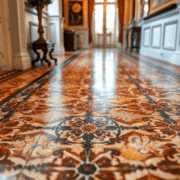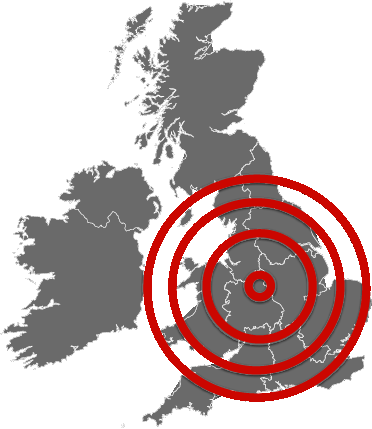The Ultimate Guide to Cleaning Victorian Tiles
Victorian tiles are beautiful examples of 19th-century craftsmanship, found in historic homes throughout the UK. With their intricate patterns and vibrant colours, these tiles are a true work of art. They were created during Queen Victoria’s reign (1837-1901) when new manufacturing methods made it possible to produce decorative floor tiles on a large scale.
Why Regular Maintenance Matters
Taking care of your Victorian tiles is essential for several reasons:
- It keeps their original beauty intact
- It prevents long-lasting damage
- It helps maintain the value of your property
- It protects against everyday wear and tear
- It extends the lifespan of these historic floors
The Risks of Neglecting Victorian Tiles
If left unattended, Victorian tiles can face serious consequences. Here’s what you need to know:
- Dirt buildup can ruin the intricate patterns
- Harsh cleaning products may strip away the original finish
- Water damage and heavy foot traffic put additional strain on these heritage features
The Importance of Professional Restoration Services
When it comes to preserving Victorian tiles, professional restoration services are crucial. Here’s how expert technicians can help:
- They use specialised cleaning solutions that are safe for historic materials
- They apply appropriate sealing techniques to protect the tiles
- They identify early signs of damage that may go unnoticed
- They provide customised maintenance plans tailored to your specific needs
- They restore original patterns and colours using traditional methods
At Tile & Stone Medic, we have over 20 years of experience in restoring Victorian floors. Our advanced cleaning methods and restoration techniques ensure that these architectural treasures remain beautiful for future generations to appreciate.
Did you know? Many Victorian tiles have unique patterns that are specific to their manufacturer? This makes proper maintenance even more important for preserving these one-of-a-kind designs.
Understanding and Preparing for the Cleaning Process
Victorian tiles have unique features that require specific cleaning methods. These historic tiles are known for their complex geometric patterns, vibrant colours, and intricate designs that showcase the artistic skill of the Victorian era. Some common patterns include:
- Encaustic designs with inlaid patterns
- Floral and botanical motifs
- Gothic-inspired geometric shapes
- Rich colour combinations of burgundy, blue, and cream
Pre-Cleaning Area Preparation
A successful cleaning process starts with proper preparation:
Clear the Space
- Remove all furniture and obstacles
- Roll up rugs and store them elsewhere
- Protect surrounding walls and skirting boards
Initial Assessment
- Check for loose or damaged tiles
- Identify areas with heavy soiling
- Document any existing damage
- Test cleaning products on a small, hidden area
Equipment Setup
- Gather necessary cleaning tools
- Position adequate lighting
- Set up ventilation
- Prepare clean water access
The unique composition of Victorian tiles demands careful handling during cleaning. These tiles often contain natural materials and historic manufacturing techniques that make them sensitive to harsh chemicals and aggressive cleaning methods. A proper understanding of their characteristics helps prevent damage during the restoration process.
Step-by-Step Guide to Cleaning Victorian Tiles Like a Pro
Ready to restore your Victorian tiles to their original splendour? Let’s dive into our professional cleaning process.
1. Initial Surface Assessment
Before diving into the cleaning process, it’s crucial to assess the condition of your Victorian tiles. This step helps you identify any potential issues that may require special attention during cleaning.
- Test a small, inconspicuous area first
- Check for loose tiles or damaged grout
- Document any existing damage with photos
2. Deep Cleaning Preparation
Preparation is key to effective cleaning. By removing loose debris and protecting surrounding surfaces, you create an optimal environment for deep cleaning.
- Remove loose debris with a soft brush
- Protect surrounding surfaces with tape
- Put on protective gear (gloves, goggles)
3. Pre-Treatment Phase
For stubborn stains that require extra care, pre-treatment is essential. This step involves applying a specialised solution to target tough stains before the main cleaning process begins.
- Apply LTP Grimex to stubborn stains
- Let it sit for 5-10 minutes
- Never allow the solution to dry on tiles
4. Main Cleaning Process
Now it’s time to get down to business! In this step, you’ll use an alkaline cleaning solution and a soft brush to tackle dirt and grime on your Victorian tiles.
- Mix alkaline cleaning solution according to instructions
- Apply Floorseal Intensive Tile Cleaner with a soft brush
- Work in small, manageable sections
- Scrub in circular motions
- Pay extra attention to grout lines
5. Agitation and Removal
After scrubbing, it’s important to remove all traces of dirt and cleaning solution from the tiles. This step involves using a professional scrubbing machine and wet vacuum for thoroughness.
- Use a professional scrubbing machine on low speed
- Hand-scrub corners and edges
- Remove dirty solution with a wet vacuum
- Rinse thoroughly with clean water
6. Second Pass Cleaning
For heavily soiled areas that still show signs of dirt after the first round of cleaning, a second pass may be necessary. This step focuses on specific details such as patterns and borders.
- Repeat process on heavily soiled areas
- Focus on pattern details and borders
- Use soft bristle brushes for intricate designs
- Remove all cleaning solution residue
Pro Tips for Best Results:
To achieve optimal results while cleaning your Victorian tiles, keep these tips in mind:
- Keep the surface damp throughout cleaning
- Change cleaning solution when it becomes dirty
- Use room temperature water for better results
- Work systematically from one end to another
- Clean grout lines separately if needed
Remember: Different tile patterns might require varying pressure levels and cleaning techniques. Always maintain consistent cleaning strokes to avoid streaking.
Dealing with Stubborn Residues and Specific Issues in Victorian Tiles
Victorian tiles often present unique challenges that require specific treatment approaches. Here’s how to tackle common stubborn issues:
Efflorescence Treatment
- Apply a specialised efflorescence remover
- Work in small sections with gentle circular motions
- Rinse thoroughly with clean water
- Repeat if white deposits persist
Rust Stains
- Use a pH-neutral rust remover
- Apply directly to affected areas
- Allow 5-10 minutes contact time
- Scrub gently with a non-metallic brush
Paint Splatter
- Apply a paint softener suitable for Victorian tiles
- Cover with plastic wrap for 30 minutes
- Remove softened paint with a plastic scraper
- Clean residue with warm water
Embedded Dirt
- Create a poultice with absorbent material
- Mix with appropriate cleaning solution
- Apply 6mm thick layer to affected area
- Cover with plastic wrap
- Leave for 24-48 hours
- Remove and clean thoroughly
Black Spots
- Identify if organic or mineral-based
- Use appropriate chemical treatment
- Apply with soft brush
- Allow designated dwell time
- Rinse completely
Remember to test any cleaning solution on a small, inconspicuous area first. Some residues might require multiple treatments for complete removal. Professional assistance is recommended for particularly stubborn or extensive issues.
Post-Cleaning Care: Drying, Sealing, and Long-Term Maintenance Tips for Victorian Tiles
Proper drying techniques play a vital role in preserving Victorian tiles after cleaning. A systematic approach ensures optimal results:
1. Initial Drying Process
- Allow natural air drying for 24 hours
- Use industrial fans to accelerate the process
- Keep the area well-ventilated
- Check corners and grout lines for moisture retention
2. Sealing Protection
- Apply impregnating sealer once completely dry
- Use a specialist Victorian tile sealer
- Apply 2-3 thin coats for maximum protection
- Allow each coat to dry between applications
3. Long-Term Care Routine
- Regular dust removal with microfibre mops
- Weekly cleaning with pH-neutral cleaners
- Quarterly deep cleaning sessions
- Annual sealer effectiveness checks
Professional Tip: Test the sealer’s effectiveness by dropping water on the tiles. If the water beads, the seal remains intact. If it absorbs quickly, it’s time for resealing.
Our specialised sealing service creates a protective barrier against:
- Daily wear and tear
- Moisture penetration
- Staining agents
- Chemical damage
- UV exposure
Regular maintenance extends the life of Victorian tiles and preserves their authentic beauty. A well-maintained sealed floor requires minimal effort to keep clean while retaining its original charm.
Repairing Damaged Areas in Victorian Tiles: A Quick Guide
Victorian tiles require careful attention when damaged. Here’s what you need to know about common repair methods:
Cracked Tiles
- Clean the affected area thoroughly
- Apply appropriate adhesive beneath loose sections
- Use gentle pressure to secure the tile
- Allow proper curing time as per adhesive instructions
Missing Tiles
- Source authentic Victorian replacements from specialist suppliers
- Match patterns and colours precisely
- Professional installation ensures seamless integration
- Consider salvaged tiles for historical accuracy
Grout Issues
- Remove damaged grout with specialised tools
- Clean joints thoroughly
- Apply period-appropriate grout mixture
- Maintain consistent joint width
When to Call Professionals
- Large-scale damage affecting multiple tiles
- Historical preservation requirements
- Complex pattern restoration
- Structural issues beneath tiles
Professional Tip: Document your tile pattern before starting repairs. Take photographs and note the layout to maintain authenticity during restoration.
Safety Considerations
- Wear protective gloves and eyewear
- Use appropriate tools for tile removal
- Keep the work area well-ventilated
- Test repair products on a small, hidden area first
Preservation Techniques
When dealing with grout issues, it’s essential to follow specific preservation techniques that can help maintain the integrity of your Victorian tiles.
Remember: Victorian tiles are irreplaceable heritage features. Careful repairs preserve their historical value and architectural significance.
Maintaining the Beauty of Victorian Tiles: A Lasting Legacy
Victorian tiles are a valuable part of our home’s architectural history. Taking care of them requires commitment, knowledge, and a gentle touch. By regularly maintaining them and seeking professional help when needed, we can ensure that these heritage features continue to share their stories for many years to come.
The benefits of properly caring for Victorian tiles go beyond just looking good:
- Increased value of the property
- Preserved historical authenticity
- Less need for major repairs
Remember: each Victorian tile pattern has its own unique character and charm. Show respect to these historic surfaces by using the right cleaning methods and seeking professional advice when necessary. With your careful attention, your Victorian tiles will reward you with everlasting beauty and timeless elegance.
A well-maintained Victorian tile floor isn’t just a surface – it’s a living piece of history beneath your feet.
FAQs
Why is regular maintenance important for Victorian tiles?
Regular maintenance is crucial for preserving the historic flooring, enhancing its longevity, and preventing damage caused by neglect. Consistent cleaning helps maintain the beauty and value of Victorian tiles over time.
What are the key steps to prepare Victorian tiles before cleaning?
Preparation involves understanding the tile characteristics, removing furniture to access all areas, and ensuring the space is ready for an effective cleaning process. This helps protect intricate details and popular styles typical of Victorian era tiles.
Which cleaning solutions are recommended for Victorian tiles?
Alkaline cleaning solutions such as LTP Grimex and Floorseal Intensive Tile Cleaner are highly recommended. These products effectively clean without damaging the delicate surface of Victorian floor tiles.
How can I remove stubborn residues and efflorescence from Victorian tiles?
Specialized treatments involving targeted residue removal techniques should be employed. Using appropriate cleaners designed for efflorescence and following expert tips ensures thorough cleaning without harming the tiles.
What post-cleaning care is essential for maintaining Victorian tiles?
Proper drying after cleaning, applying an impregnating sealer, and sealing the tiles are vital steps. These practices protect the tiles from moisture damage and help preserve their appearance in the long term.
How should damaged areas on Victorian tiles be repaired?
Damaged areas require careful handling using suitable tile repair methods, adhesives, and grout replacements. Seeking expert advice is recommended to ensure repairs respect the historic nature of the flooring and maintain its integrity.


